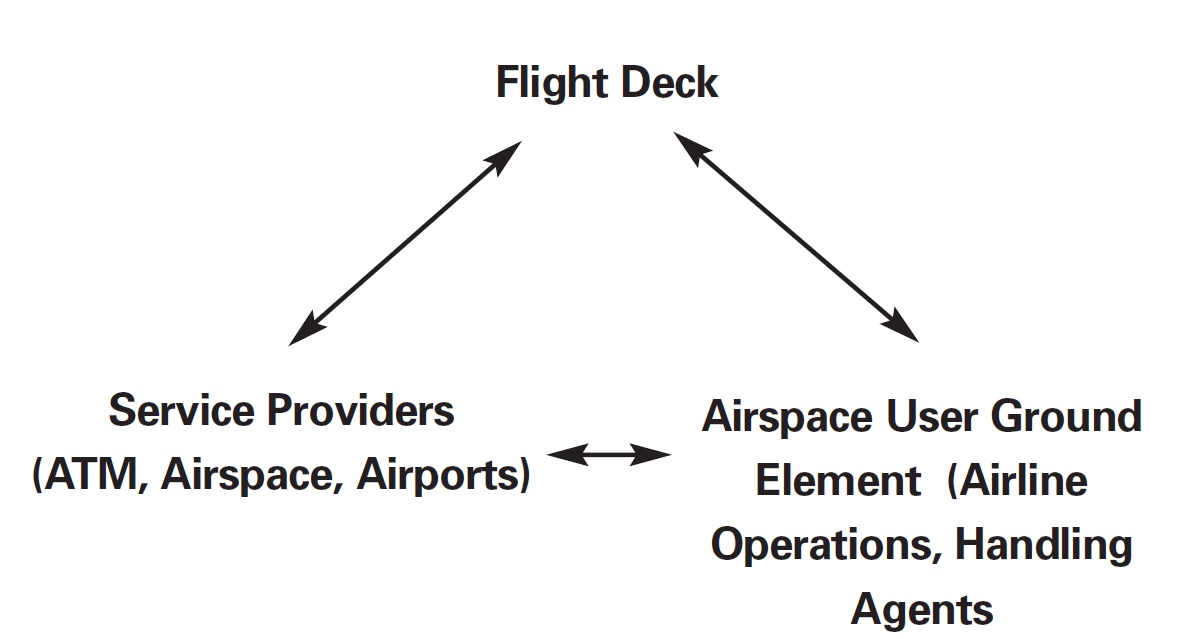As a product of the ICAO Global ATM Concept, FF-ICE defines information requirements for flight planning, flow management and trajectory management and aims to be a cornerstone of the performance-based air navigation system. Flight information and associated trajectories are principal mechanisms by which ATM service delivery will meet operational requirements.
FF-ICE will have global applicability and will support all members of the ATM community to achieve strategic, pre-tactical and tactical performance management. FF- ICE emphasizes the need for information sharing to enable significant benefits.
The exchange of flight/flow information will assist the construction of the best possible integrated picture of the past, present and future ATM situation. This exchange of information enables improved decision making by the ATM actors involved in the entire duration of a flight, i.e. gate-to-gate, thus facilitating 4-D trajectory operations.
FF-ICE envisages that definitions of data elements are globally standardised and provides the mechanisms for their exchange. Thus, with appropriate information management, a Collaborative Decision Making environment is facilitated enabling the sharing of appropriate data across a wider set of participants resulting in greater coordination of the ATM community, situational awareness and the achievement of global performance targets.
The future collaborative and dynamic flight information process will involve the full spectrum of ATM Community members as envisaged in the ATM Global Operational Concept. The cornerstone of future air traffic management is the interaction between these various parties and FF-ICE allows dynamic exchange of information.

The Global ATM concept, facilitated through regional programmes such as SESAR (Single European Sky ATM Research) in Europe, NextGen (Next Generation Air Transportation System) in North America and CARATS (Collaborative Action for Renovation of Air Traffic Systems) in Japan, foresees Air Traffic Control becoming traffic management by trajectory. The roles of the parties illustrated above will evolve to support the requirements of this concept which will:
Entail systematic sharing of aircraft trajectory data between actors in the ATM process
Ensure that all actors have a common view of a flight and have access to the most accurate data available
Allow operations respecting the airspace users’ individual business cases
Trajectory management will be carried out both strategically and tactically as illustrated below:

In the figure above, the operator’s ‘desired’ trajectory is not possible because airspace allocated to military use in a neighbouring State/FIR is unavailable for civil use. This is known as a constraint which can be generated by any of the participants in the ATM system. For example, the aircraft may be limited to a maximum altitude or departure from a particular airport may be limited to rigid routeings for environmental reasons. As a result the ‘agreed’ trajectory is determined before departure so that it avoids the airspace constraint. This is commonly referred to as strategic ATM.

In the figure above, the military use of the airspace has finished early but after the departure of the flight concerned. Trajectory management facilitated by FF-ICE, which includes cross-border and/or inter-state information exchange, now allows the participants concerned, in this case airspace user and ATM service provider, to re-negotiate the trajectory so that the ‘actual’ trajectory is as close as possible to the ‘desired’. This is commonly referred to as tactical ATM and relies on comprehensive information exchange between all ATM participants without State/FIR boundaries providing a constraint.
Once FF-ICE is created all interested and authorised parties will have access to all the information it contains. Mechanisms will be in place to manage information. creation and updates from multiple authorised parties. Although focussing on flight and flow information, FF-ICE makes assumptions regarding interaction with other information areas such as meteorology, aeronautical information and infrastructure status. All participants are expected both to provide and utilise shared information but, for performance reasons, different data elements will be required under different circumstances, locations and times. The constant exchange of information by all parties within the overall collaborative environment is fundamental to both strategic and tactical ATM.
